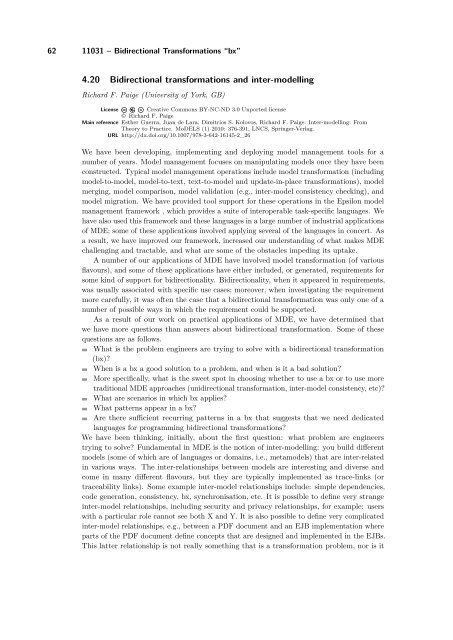Volume 1, Issue 1, January 2011 - DROPS - Schloss Dagstuhl
Volume 1, Issue 1, January 2011 - DROPS - Schloss Dagstuhl
Volume 1, Issue 1, January 2011 - DROPS - Schloss Dagstuhl
You also want an ePaper? Increase the reach of your titles
YUMPU automatically turns print PDFs into web optimized ePapers that Google loves.
62 11031 – Bidirectional Transformations “bx”<br />
4.20 Bidirectional transformations and inter-modelling<br />
Richard F. Paige (University of York, GB)<br />
License Creative Commons BY-NC-ND 3.0 Unported license<br />
© Richard F. Paige<br />
Main reference Esther Guerra, Juan de Lara, Dimitrios S. Kolovos, Richard F. Paige: Inter-modelling: From<br />
Theory to Practice. MoDELS (1) 2010: 376-391, LNCS, Springer-Verlag.<br />
URL http://dx.doi.org/10.1007/978-3-642-16145-2_26<br />
We have been developing, implementing and deploying model management tools for a<br />
number of years. Model management focuses on manipulating models once they have been<br />
constructed. Typical model management operations include model transformation (including<br />
model-to-model, model-to-text, text-to-model and update-in-place transformations), model<br />
merging, model comparison, model validation (e.g., inter-model consistency checking), and<br />
model migration. We have provided tool support for these operations in the Epsilon model<br />
management framework , which provides a suite of interoperable task-specific languages. We<br />
have also used this framework and these languages in a large number of industrial applications<br />
of MDE; some of these applications involved applying several of the languages in concert. As<br />
a result, we have improved our framework, increased our understanding of what makes MDE<br />
challenging and tractable, and what are some of the obstacles impeding its uptake.<br />
A number of our applications of MDE have involved model transformation (of various<br />
flavours), and some of these applications have either included, or generated, requirements for<br />
some kind of support for bidirectionality. Bidirectionality, when it appeared in requirements,<br />
was usually associated with specific use cases; moreover, when investigating the requirement<br />
more carefully, it was often the case that a bidirectional transformation was only one of a<br />
number of possible ways in which the requirement could be supported.<br />
As a result of our work on practical applications of MDE, we have determined that<br />
we have more questions than answers about bidirectional transformation. Some of these<br />
questions are as follows.<br />
What is the problem engineers are trying to solve with a bidirectional transformation<br />
(bx)?<br />
When is a bx a good solution to a problem, and when is it a bad solution?<br />
More specifically, what is the sweet spot in choosing whether to use a bx or to use more<br />
traditional MDE approaches (unidirectional transformation, inter-model consistency, etc)?<br />
What are scenarios in which bx applies?<br />
What patterns appear in a bx?<br />
Are there sufficient recurring patterns in a bx that suggests that we need dedicated<br />
languages for programming bidirectional transformations?<br />
We have been thinking, initially, about the first question: what problem are engineers<br />
trying to solve? Fundamental in MDE is the notion of inter-modelling: you build different<br />
models (some of which are of languages or domains, i.e., metamodels) that are inter-related<br />
in various ways. The inter-relationships between models are interesting and diverse and<br />
come in many different flavours, but they are typically implemented as trace-links (or<br />
traceability links). Some example inter-model relationships include: simple dependencies,<br />
code generation, consistency, bx, synchronisation, etc. It is possible to define very strange<br />
inter-model relationships, including security and privacy relationships, for example: users<br />
with a particular role cannot see both X and Y. It is also possible to define very complicated<br />
inter-model relationships, e.g., between a PDF document and an EJB implementation where<br />
parts of the PDF document define concepts that are designed and implemented in the EJBs.<br />
This latter relationship is not really something that is a transformation problem, nor is it













